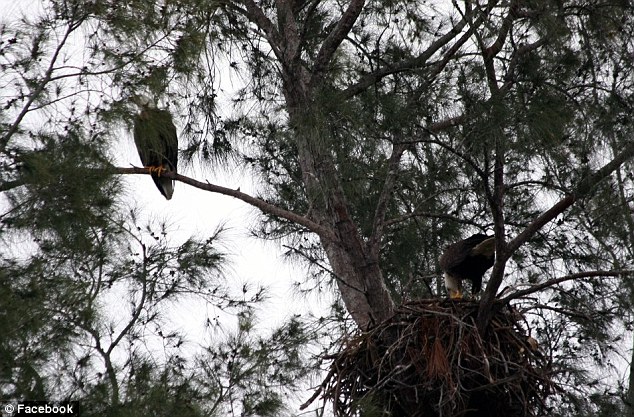A bald eagle had to be rescued over the weekend from a tree in Naples, Florida, after it got caught in in a fishing line and was left dangling upside down until help arrived.
Naples resident Bob Bodemann called firefighters Sunday when he spotted the eagle ensnared in a tree in his yard.
A mating pair and their two young birds occupy a nest in a Norfolk Pine not far from Bodemann's home on 14th Avenue South.
The man had first seen the bird sitting on his lawn earlier in the day, and noticed that its leg appeared chewed up, but the animal managed to fly off, according to the Naples Daily News.
Later, the homeowner was getting ready to go out when he looked up and spotted a bald eagle hanging in the tree.
Naples firefighters, City Beach Patrol officers and wildlife officials from the Conservancy of Southwest Florida arrived on the scene at around 9.30am, just 20 minutes after Bodemann made the call.
First responders climbed a 70-foot ladder to reach the stranded bird. For 45 minutes, rescuers worked to untangle the fishing line that left the critter stranded as the bald eagle flapped its massive wings.
'The bird obviously started hesitating and freaking out severely and trying to get out of the situation,' Beach Patrol Specialist Casey Bollenback said.
Eventually, the fishing line snapped and the eagle took off under its own wing.
According to Bodemann, about 150 feet of fishing line was removed from the animal, but rescuers believe the lure might still be stuck to its back.
On Tuesday, Bodemann put up a photo of an eagle sitting in a tree accompanied by a message: 'Good News! Both eagles at the nest today, and both look fine. Yeah! Thank the Lord!'
The bald eagle, the national bird of the United States, instantly recognizable thanks to its distinctive brown body and white head, is the only eagle unique to North America.
The birds grow up to three feet in height with a wingspan of about six-and-a-half feet. Female bald eagles are larger than the males.
The population of bald eagles numbers about 5,000 nesting pairs in the U.S. The animals live near large lakes in Canada and Alaska, where they are especially populous, and in scattered locations thought the lower 48 states and Mexico.
SOURCE






Blessings to you...you are all Heroes!